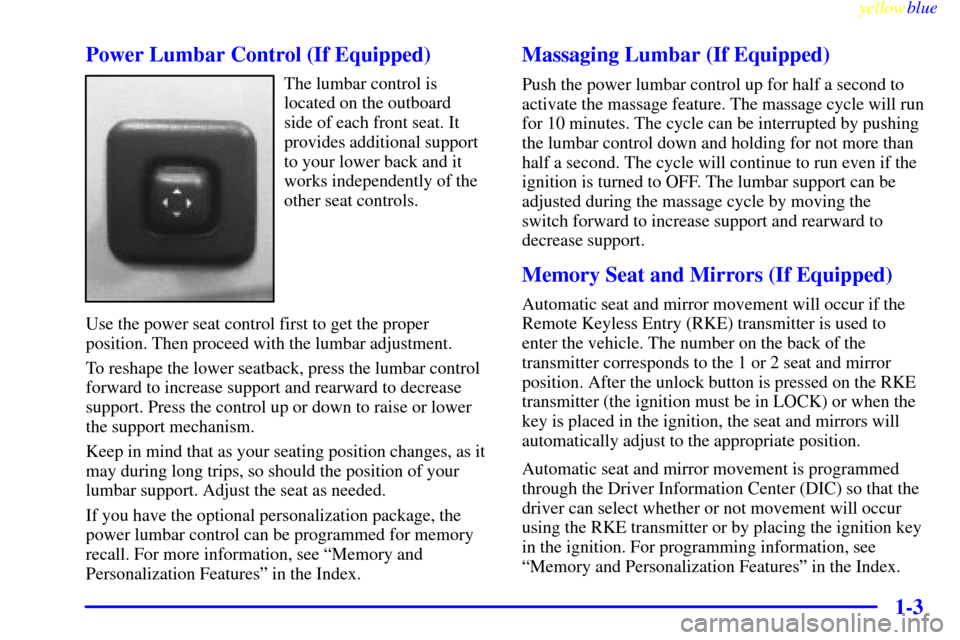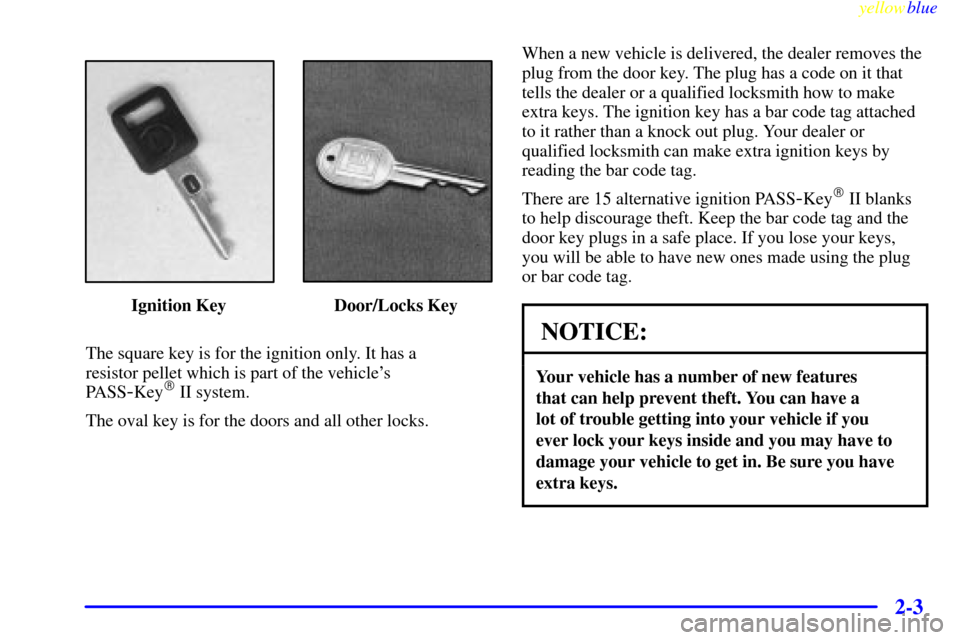Page 9 of 344

yellowblue
1-3 Power Lumbar Control (If Equipped)
The lumbar control is
located on the outboard
side of each front seat. It
provides additional support
to your lower back and it
works independently of the
other seat controls.
Use the power seat control first to get the proper
position. Then proceed with the lumbar adjustment.
To reshape the lower seatback, press the lumbar control
forward to increase support and rearward to decrease
support. Press the control up or down to raise or lower
the support mechanism.
Keep in mind that as your seating position changes, as it
may during long trips, so should the position of your
lumbar support. Adjust the seat as needed.
If you have the optional personalization package, the
power lumbar control can be programmed for memory
recall. For more information, see ªMemory and
Personalization Featuresº in the Index.
Massaging Lumbar (If Equipped)
Push the power lumbar control up for half a second to
activate the massage feature. The massage cycle will run
for 10 minutes. The cycle can be interrupted by pushing
the lumbar control down and holding for not more than
half a second. The cycle will continue to run even if the
ignition is turned to OFF. The lumbar support can be
adjusted during the massage cycle by moving the
switch forward to increase support and rearward to
decrease support.
Memory Seat and Mirrors (If Equipped)
Automatic seat and mirror movement will occur if the
Remote Keyless Entry (RKE) transmitter is used to
enter the vehicle. The number on the back of the
transmitter corresponds to the 1 or 2 seat and mirror
position. After the unlock button is pressed on the RKE
transmitter (the ignition must be in LOCK) or when the
key is placed in the ignition, the seat and mirrors will
automatically adjust to the appropriate position.
Automatic seat and mirror movement is programmed
through the Driver Information Center (DIC) so that the
driver can select whether or not movement will occur
using the RKE transmitter or by placing the ignition key
in the ignition. For programming information, see
ªMemory and Personalization Featuresº in the Index.
Page 10 of 344
yellowblue
1-4 Heated Front Seat (Option)
The control is located in the
center console. Move the
switch to LO or HI to turn
on the heating elements in
the seat. The LO setting
warms the seatback and
cushion until the seat
approximates body
temperature. The HI setting
heats the seat to a slightly
higher temperature.
A telltale light in the control reminds you that the
heating system is in use. The heated seats can only be
used when the ignition is turned on.
Reclining Front Seatbacks
The reclining front seatback
control is located on the
outboard side of each front
seat. Press the control
forward or rearward to
adjust the seatback.
Page 33 of 344
yellowblue
1-27
CAUTION:
For up to 10 seconds after the ignition key is
turned off and the battery is disconnected, an air
bag can still inflate during improper service. You
can be injured if you are close to an air bag when
it inflates. Avoid yellow connectors. They are
probably part of the air bag system. Be sure to
follow proper service procedures, and make sure
the person performing work for you is qualified
to do so.
The air bag system does not need regular maintenance.
Rear Seat Passengers
It's very important for rear seat passengers to buckle up!
Accident statistics show that unbelted people in the rear
seat are hurt more often in crashes than those who are
wearing safety belts.
Rear passengers who aren't safety belted can be thrown
out of the vehicle in a crash. And they can strike others
in the vehicle who are wearing safety belts.
Page 57 of 344

2-
yellowblue
2-1
Section 2 Features and Controls
Here you can learn about the many standard and optional features on your vehicle, and information on starting,
shifting and braking. Also explained are the instrument panel and the warning systems that tell you if everything is
working properly
-- and what to do if you have a problem.
2
-2 Keys
2
-4 Door Locks
2
-6 Remote Keyless Entry (RKE) System
2
-9 Trunk
2
-13 Theft
2
-14 Theft-Deterrent System (If Equipped)
2
-16 PASS-Key� II
2
-17 New Vehicle ªBreak-Inº
2
-17 Ignition Positions
2
-19 Starting Your Engine
2
-20 Engine Coolant Heater (If Equipped)
2
-21 Automatic Transaxle Operation
2
-25 Parking Brake
2
-27 Shifting Into PARK (P)
2
-29 Shifting Out of PARK (P)
2
-30 Parking Over Things That Burn
2
-30 Engine Exhaust2
-31 Running Your Engine While You're Parked
2
-32 Windows
2
-33 Tilt Wheel
2
-33 Turn Signal/Multifunction Lever
2
-40 Exterior Lamps
2
-43 Interior Lamps
2
-45 Mirrors
2
-49 Storage Compartments
2
-51 Sun Visors
2
-51 Cellular Telephone (Option)
2
-52 Sunroof (Option)
2
-53 Universal Transmitter (Option)
2
-56 The Instrument Panel -- Your
Information System
2
-61 Warning Lights, Gages and Indicators
2
-70 Driver Information Center (DIC)
Page 58 of 344
yellowblue
2-2
Keys
CAUTION:
Leaving children in a vehicle with the ignition
key is dangerous for many reasons. A child or
others could be badly injured or even killed.
They could operate power windows or other
controls or even make the vehicle move. If they
turned the ignition to RUN and moved the shift
lever out of PARK (P), that would release the
parking brake. Don't leave the keys in a vehicle
with children.
Page 59 of 344

yellowblue
2-3
Ignition Key Door/Locks Key
The square key is for the ignition only. It has a
resistor pellet which is part of the vehicle's
PASS
-Key� II system.
The oval key is for the doors and all other locks.When a new vehicle is delivered, the dealer removes the
plug from the door key. The plug has a code on it that
tells the dealer or a qualified locksmith how to make
extra keys. The ignition key has a bar code tag attached
to it rather than a knock out plug. Your dealer or
qualified locksmith can make extra ignition keys by
reading the bar code tag.
There are 15 alternative ignition PASS
-Key� II blanks
to help discourage theft. Keep the bar code tag and the
door key plugs in a safe place. If you lose your keys,
you will be able to have new ones made using the plug
or bar code tag.
NOTICE:
Your vehicle has a number of new features
that can help prevent theft. You can have a
lot of trouble getting into your vehicle if you
ever lock your keys inside and you may have to
damage your vehicle to get in. Be sure you have
extra keys.
Page 61 of 344

yellowblue
2-5 Power Door Locks
Press the power door lock switch to lock or unlock both
doors at once.
Automatic Door Locks
Close your doors and turn on the ignition. Every time
you move the shift lever out of PARK (P), both doors
will lock. The doors will unlock every time you stop the
vehicle and move the shift lever back into PARK (P). If
someone needs to get out while your vehicle is not in
PARK (P), have that person use the manual or powerdoor lock. When the door is closed again, it will not
lock automatically. Use the manual or power door lock
to lock the door again. If you need to lock the doors
before shifting out of PARK (P), use the manual or
power door lock.
Programmable Automatic Door Locks
(If Equipped)
With the ignition in RUN, the door locks can be
programmed through prompts displayed by the Driver
Information Center (DIC). These prompts allow the
driver to choose various lock settings. For programming
information, see ªMemory and Personalization
Featuresº in the Index.
Anti-Lockout Feature
Leaving your key in any ignition position with either
door open will disable the use of the power door lock
switches as well as the lock button on the remote keyless
entry transmitter. If you close the doors, you can lock
them using the remote keyless entry transmitter. It is
always recommended that you remove your ignition
key when locking your vehicle.
Note: The anti
-lockout feature can be overridden by
holding the driver's power door lock switch for three
seconds or longer.
Page 69 of 344

yellowblue
2-13
Theft
Vehicle theft is big business, especially in some cities.
Although your vehicle has a number of theft
-deterrent
features, we know that nothing we put on it can make
it impossible to steal. However, there are ways you
can help.
Key in the Ignition
If you leave your vehicle with the keys inside, it's an
easy target for joy riders or professional thieves
-- so
don't do it.
When you park your vehicle and open the driver's door,
you'll hear a chime reminding you to remove your key
from the ignition and take it with you. Always do this.
Your steering wheel will be locked, and so will your
ignition and transaxle. And remember to lock the doors.
Parking at Night
Park in a lighted spot, close all windows and lock your
vehicle. Remember to keep your valuables out of sight.
Put them in a storage area, or take them with you.
Parking Lots
If you park in a lot where someone will be watching
your vehicle, it's best to lock it up and take your keys.
But what if you have to leave your ignition key?
�If possible, park in a busy, well lit area.
�Put your valuables in a storage area, like your
trunk or glove box. Be sure to close and lock the
storage area.
�Close all windows.
�Lock the glove box.
�Lock all the doors except the driver's.
�Then take the door key and remote keyless entry
transmitter with you.